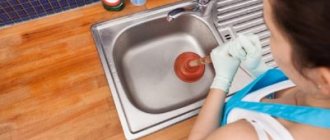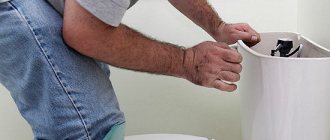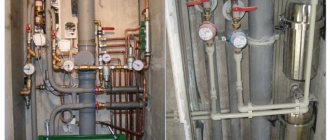A clogged drain is the most common cause of poor water flow in the bathroom. But the sink drain, and especially the kitchen sink, gets clogged just as much. kitchen sink and bath. To effectively solve the problem, you need to know the cause of its occurrence and methods to prevent the formation of a traffic jam. “Plumber Portal” will tell you about cleaning methods when the water in the bathroom does not drain.
Operational blockage
Why does the water drain poorly from the bathtub? The problem may be caused by operational blockage that occurs as a result of ignoring preventive measures or improper operation of the system. There are natural causes that contribute to the deterioration of pipes over time. For example, this is cold water and fat. The soap or gel used for everyday hygienic showering is not enough to dissolve the grease in the sewer pipes. Small debris gradually accumulates and a blockage forms. The situation is aggravated if you do not regularly clean pipes and plumbing with special detergents.
Mechanical cleaning using a cable
What to do in a situation where boiling water combined with a plunger cannot clear blockages in the sewer? In this case, the surest way would be a cable. Care should be taken, as this device can easily damage plastic pipes and cause them to leak.
To make a cable yourself, you will need a metal flexible wire. Then one end of the cable must be bent to form a small hook. It will be convenient for them to catch debris stuck in the drain hole and pull it out. As for the second end, a piece of fabric should be tied to it, making a handle.
You need to carefully insert the cable inside the drain pipe and try to push through the accumulated dirt. For better cleaning, you can rotate the device clockwise. Then you need to pull out the cable with the remaining debris.
To completely remove the clog, you need to flush the drain with a strong stream of boiling water from the shower or tap. This method is one of the most effective today. This is what most plumbers use.
Man-made pipe blockage
Is the water draining poorly from your bathroom sink? This happens when technology is violated at the stage of construction work, wear of basic elements and in case of accidents on communications. This includes an incorrect angle of inclination of the outlet pipe, freezing or rupture of the pipe, errors in choosing a site for laying communications, and the like. In this case, it is unlikely that you will be able to fix the problems without the help of plumbers.
Reasons for stagnation
When water does not drain well, it can have various origins:
- mechanical - formed due to foreign objects entering the drain pipe - human hair, animal hair, fabric fibers, sand or earth;
- operational - emergencies in the communications system, wear and tear of equipment.
The small slope of the sewer pipe is a drawback made during the repair work. A narrow pipe (small diameter) of a sewer drain is a mistake made during repairs or planning.
The pipes in the bathroom are humming - you can read how to solve the problem in the materials on our website.
You can read more about options for clearing sewer blockages in this article.
Proper removal of blockages
If the water in the bathroom does not drain well, what should you do? You can only get rid of mechanical blockages on your own, but it is likely that this will not help or will not fix the problem for long. It is not enough to clean the pipes mechanically (with a plumbing cable or plunger) or using aggressive household chemicals.
Hydrodynamic cleaning is very effective, but for this it is necessary to supply water to the sewer system under pressure. You will need special hoses and a compressor to provide sufficient pressure. This is the fastest and safest way to clean pipes, but you will need to hire professionals.
In practice, only an integrated approach to the problem will help eliminate the blockage and forget about it for a long time in the future. Cleaning the drain system is inseparable from the measures for cleaning the sewer pipe, because small debris is not distributed locally in one area, but along the entire length of the sewer riser and discharge pipe. You can do everything yourself.
How to fix
Inside the bathroom
We first determine the location of the blockage. If water does not drain from the sink, but does not linger in the bathroom, the sink siphon is clogged. When there is a bad odor coming from your bathtub drain and strands hanging off the crossbar, the U-flap or corrugation is likely clogged.
If the water drains at first and then stands, it may be a riser. With a combined kitchen and toilet sewer system, proper functioning of the toilet indicates a clogged wiring inside the room.
There are three cleaning methods:
- hydraulic;
- mechanical;
- chemical.
Hydraulic “emergency” is carried out with a plunger; at the initial stage it is usually possible to break through the plug. The plunger allows you to clean the system by alternately creating a vacuum - excess pressure by a compressible rubber valve. The liquid, together with the dirt, rushes under the kvach by inertia. Hair caught on the crosspiece is removed with a crochet hook.
Close the overflow hole tightly with your palm (or a wet rag) for efficient operation of the kvacha. To prevent the rubber valve from sucking in air, immerse it halfway in water.
Plungers for sinks and toilets are sold; the latter have a tapering nozzle. Plumbers have powerful piston ones in their arsenal, however, this is not a panacea, since the joints of the plastic wiring cannot withstand excess pressure. Specialists use high-pressure units for hydrodynamic sewer cleaning:
Mechanical cleaning is combined with using a plunger. They use wire hooks, polymer brushes, and devices for winding threads. As a rule, a steel cable is used during partial disassembly, otherwise it is easy to break through the corrugation. The cargo cable and steel wire (“steel wire”) are inferior to the plumbing cable, wound in the form of a flexible shaft with a cross-section of 10–16 mm.
Adviсe:
Accessories:
The equipment listed above helps to temporarily restore patency. The issue can be radically resolved by dismantling the clogged unit. To clean the flat siphon:
- Loosen the union nut connecting the flat elbow to the neck fitting.
- Unscrew the nut connecting the adapter to the outlet or corrugated hose connected to the sewer.
- Remove the elbow along with the adapter (it is acceptable to leave the adapter).
Removing the flat elbow
- Disassemble the assembly by unscrewing the coupling nuts, clean and rinse.
- Check the permeability of the outlet and the area behind it with a wire. The folds of the corrugation trap dirt, so take it out and rinse the sleeve.
- Replace stretched conical seals. Reassemble in reverse order.
Assembling and disassembling the siphon:
Leaking joints are untwisted, dried, coated with silicone sealant, assembled, and the composition is waited for complete hardening according to the instructions on the tube.
The chemical method is more of a preventative measure. Factory-made products are effective against grease, but are powerless to dissolve scale; they will not overcome a ball of hair; the restoration of patency will be temporary.
Be sure to wear protective gloves! Follow the instructions on the bottle label regarding the dosage of the drug, exposure time, and safety precautions.
Do not rely on craftsmen’s recipes, especially those containing acids: excessive concentrations of solutions will damage gaskets, damage the coating of plumbing fixtures, and pose a health risk.
Notes on the device design
Bottle and tubular U-shaped models are designed for sinks; the former are more convenient to maintain. Bathtubs are often equipped with compact U-shaped flat ones. For cheap corrugated siphons, the shutter is installed by bending an accordion accordingly; the design is small-sized, but unreliable. A rigid connection with wiring is preferable to a flexible corrugated hose, but requires precise installation.
Pipe U-shaped.
Bottle
The bottle model does not require complete disassembly; just unscrew the settling tank. Leave a gap between the end of the vertical pipe and the bottom of the tank, otherwise deposits will quickly fill the gap. The distance is adjusted by moving the body along the pipe (for adjustable structures), fixing the position with nuts.
Don't forget to place a basin or bucket under the sink before starting work.
Unscrew the bottom.
Disconnect the sleeve.
We remove the body.
We wash it and put it back.
Sewer riser
In five-story Khrushchev buildings, inspection hatches are provided on the first and top floors; tall buildings were equipped with inspection hatches every three floors. Local cleanouts were also installed - outlets closed with plugs.
The risers of the current plastic network are equipped with revision tees with threaded covers. Similar smaller devices are installed near problem areas: walled up, hidden, sharp bends.
Briefly about the revisions:
If there is no hatch, it is advisable to disconnect the toilet corrugation to gain access to the riser tee. If there is a hard connection, you will have to remove the toilet or clean it through it.
Connecting the toilet using rigid bends.
Clean with a special cable with a handle. The tip can be equipped with hooks that hold fibers, strands, bags, and rags when pulling. It happens that they attach a pointed blank (for example, the peak of a jackhammer), break through the blockage, periodically lifting it and letting it fall freely, it is convenient to operate from the attic:
From the apartment proceed as follows:
- Remove the threaded inspection cover (flanged for cast iron).
- Lower the cable until it stops against the obstacle.
- Holding the whip with your hand, simultaneously rotate the handle.
- They impart a reciprocating motion to the wire to break through the barrier. Periodically remove and remove any trapped debris.
There is a danger of pushing the congestion lower. Then you will have to ask the residents of the lower apartment to open the audit, pushing the blockage towards them and removing the contents by hand. To prevent it from falling further, first plug the inner hole with a rag tied from the outside. Carefully monitor the movement of the spiral; it happens that repairmen pierce the plastic or run the wire towards the neighbors.
They produce mechanized cables with a set of attachments:
The worst option is a cast iron riser laid inside concrete panels. You can only get to it through repair hatches or from the attic. Wet walls of the entrance between floors indicate poor permeability of coupling joints: sewage stagnates and leaks through loosely caulked joints. For repairs, it is necessary to dismantle the brickwork covering the technical openings in the entrance.
An example from experience: “metalworkers” pulled out a drain pipe in the attic, dumping slag into the riser, and the cast-iron sewer system became tightly clogged. It was not possible to break through the jam with a cable or a load. The plumbers dismantled the masonry of the opening in the entrance, cut out a pipe segment with a grinder, and removed a bucket of slag. The hole was closed with a rolled sheet, welded with an electrode using cast iron.
External reasons
The sewage system in the basement or manhole usually becomes clogged due to the fault of careless residents who wash away unusable preserves, rags, bags, and construction waste. The latter can indirectly point to the culprit of the emergency.
The approximate location of the blockage is sometimes visible from the joints leaking under high pressure. Don’t try to do something yourself, call the management company. A clogged well is filled with sewage flowing out, and it’s time to call an emergency.
Cleaning the drain and siphon
Small debris that turns into rotting sludge or mold that emits a foul odor is usually collected in the drain and siphon. To clean these areas, you need to remove the siphon and unscrew the mesh that holds the tube. The entire contents of the siphon must be thrown into the toilet and flushed several times. Bowls, all internal tubes, gaskets, mesh and siphon should be washed thoroughly under running water with a degreaser. It's okay if you don't have a special detergent for your plumbing. Regular dishwashing detergent effectively dissolves fats and removes dirt.
What to do if traditional methods do not help?
Chemical products that are sold in hardware stores will help you quickly and effectively get rid of clogged debris. They are designed to remove organic contaminants (hair, pet dander, food debris, etc.). They resort to their help when it is impossible to cope with a clogged bathroom using folk remedies.
In what form is it best to purchase household chemicals? Despite the fact that such drugs are sold in the form of foam, powders, gels and granules, they all have an almost identical composition.
Cleaning clogged sewer pipes in the bathroom with KROT cleaning agent - video:
The following tips will help you clean a heavily dirty pipe:
- it is very important to read the instructions before using chemical clog removers;
- experts recommend choosing solvents in order to remove blockages based on the nature of the pipe (for example, plastic or cast iron);
- Both powder and liquid preparations have the same effectiveness, so it does not matter which type of preparation will be used to clear a severe blockage in the bathroom;
- Clogging solvents in liquid form are immediately poured into the drain, and granules or powders are poured out, and then boiling water is poured into them;
- After the drug has run out of time allotted to it by the instructions, you need to thoroughly rinse the drain with a stream of hot water.
It is also very important to use rubber protective gloves when working with such chemicals.
Mechanical cleaning
If the water still flows poorly into the bathroom drain, you need to mechanically clean the sewer pipes. This is done before installing the siphon and other parts of the system. It is best to use a plumbing cable that is screwed into the system. To remove debris, the cable must be pulled out and cleaned periodically. It is necessary to push it until the blockage is completely removed. Once the debris is removed, the water will begin to drain normally.
To clean the system with a plunger, you need to fill the bath with water so that the valve is completely hidden. It is better to first cover the area around with film and change into overalls - the work can be dirty. The drain hole must be covered with the rubber part of the plunger, and then begin to press on the handle to push the blockage into the pipe along with the stagnant water. To flush the system as best as possible, after clearing the blockage, it is advisable to refill the bathtub with hot water and flush it.
Subtleties and nuances of the system cleaning process
Some homeowners who experience a clog in their kitchen sink decide what to do on their own. This is the wrong approach unless you have a specialized plumbing background. Different types of plugs and different piping systems require individual attention.
For example, plastic drain pipes cannot be cleaned with mechanical cables. Also, you cannot pour boiling water and some chemicals into them, otherwise the material will be seriously damaged.
Two-piece sinks require cleaning both drains at the same time. There are also other nuances that only professional plumbers know about.
Even when working with an ordinary plunger, you can make a mistake. In the best case scenario, you simply will not be able to “break” the traffic jam. There is also a risk of system damage! That is why it is much more advisable to immediately contact the Plumber Service. We will take into account all the nuances, choose the right cleaning method and complete it quickly.
Cleaning with household chemicals
After completing all of the above steps, all that remains is to clean the sewer system using household chemicals. A packet of detergent, which breaks down fats, softens plaque and kills pathogenic microorganisms, should be poured down the drain. You need to leave it for 15-40 minutes (the exact time is indicated in the instructions for the detergent), and then rinse the pipes with running hot water for 10-15 minutes.
Other effective ways
If the bathtub is not too clogged, you can use lemon. To do this, squeeze the juice from three medium-sized citrus fruits into the drain and wait 40-60 minutes. To get more juice, you can first keep the lemons in boiling water. After this, you need to flush the drain with very hot water. Thanks to this method, not only the debris in the bath is eliminated, but also the unpleasant odor.
Video - proven cleaning methods:
You can remove dirt in the drain hole with a vacuum cleaner equipped with a backflow function. The action of this method is based on the use of strong air pressure. Experts do not recommend using this method, as water may get into the vacuum cleaner. If you nevertheless decide to remove the blockage in the bathtub using this method, you should wipe the rim of the drain hole dry. Then attach the vacuum cleaner tube, previously wrapped with a rag, to the drain and turn on the reverse blowing.
Incorrect pipe slope
If the water in the bathroom does not drain well, but there is no blockage, then the cause of the problem most likely lies in a violation of the plumbing technology. Perhaps the pipe slope is insufficient, so that the draining water does not reach the socket. This is determined visually. To increase the slope of the pipe, you need to lower or raise the bath.
The standard maximum slope is 15%. The optimal value is 30-50 mm per meter of pipe. With slopes less than 15 or more than 60 mm, the likelihood of blockages significantly increases. In addition, it is not recommended to install corner elements at 90 degrees when laying the system. If necessary, it is better to install two turns at 45 degrees.
Insufficient section size
Is the water draining poorly in the bathroom? If the “wrong” pipes are installed, you will have to change the entire system so that you no longer face the problem of constant blockages. Previously, designers were generally limited to three sections: 150 mm cast iron pipes were rarely used inside buildings, risers were assembled from 100 mm ones, and the rest were assembled from 50 mm ones. Today, the range of products has expanded significantly. In most cases, pipe diameter and configuration are selected based on recommendations and regulatory requirements.
For internal networks, any available diameter of cast iron (50, 100, 150 mm) or plastic (16-160 mm) sewer pipe can be used. A cross-section of 32 mm or more is suitable for a bathroom sink where fats do not drain. For kitchen sinks, bath and shower drains, washing machines and dishwashers, a pipe of at least 40 mm in diameter is required. For a combined bathtub and shower drain, it is better to choose 50 mm, more than three appliances without a toilet are connected to a horizontal “bed” 60 mm, more than five appliances - 75 mm, toilet and vertical risers - 100-110 mm.
Preventing blockages
Is the water draining poorly in the bathroom? After comprehensive cleaning of the system, it is necessary to carry out preventive maintenance from time to time so that the problem does not arise again and again. You can install filters and meshes (grids) on the drain, which reliably protect the internal parts of the plumbing from small debris. Every few days you need to flush the system with hot water to protect the pipes from the accumulation of fatty deposits. In addition, plumbing needs periodic preventive cleaning (both mechanically and with household chemicals).
The reason why the water in the bathroom does not drain well (video)
We remind you once again that gloves, goggles and a respirator (petal) are not jokes at all, but practical safety measures that will help you not get hurt and not inhale harmful fumes.
If the water in the bathroom is not draining well, it’s time to clean the drain . Do this once correctly, use simple prevention once every 1-1.5 months, and you will close the issue forever.
- Author: Vasily
Rate this article:
- 5
- 4
- 3
- 2
- 1
(3 votes, average: 2.7 out of 5)
Share with your friends!











